
Table of Contents
Public health nurses: bringing health home
Living longer, living healthier: health education in the curative age, 1921 to 1947
Mass marketing and social change: the postwar era | Health promotion in the modern era: 1974 and beyond
The promotion of healthy living in Ontario: timeline
|
|
||||
![Cover: The World Health Organization, Supplement no. 41 to Canada’s Health and Welfare, [ca. 1966]](pics/40219-who-supp-41-270.jpg)
Click to see a larger image (308K)
|
![The World Health Organization, Supplement no. 41 to Canada’s Health and Welfare; Preamble to the Constitution, [ca. 1966], Page](pics/40220-who-supp-41-270.jpg)
Click to see a larger image (314K) |
|||
|
|
||||
|
The success of mass immunization campaigns and the availability of a large variety of new drugs and treatments meant that the prevention of disease and the promotion of health were more possible than ever. Large-scale advertising campaigns and “social marketing” tools became the norm, as the government took a much more active role in the promotion of healthy living.
Protect your child against poliomyelitis, diphtheria, tetanus, whooping cough, smallpox
|
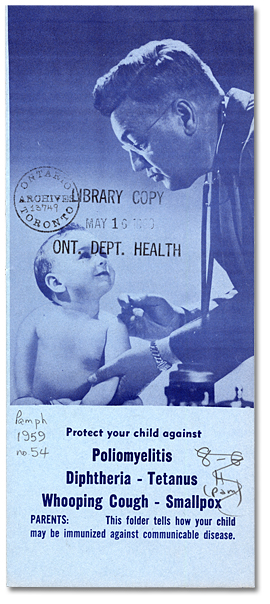
|
|||
|
||||
|
|
||||
Tuberculosis (TB) was still a major public health concern. Mobile clinics were still
active, and new cases were discovered across the province. But the numbers of those
infected with TB began to dramatically decline by the late 1950s.
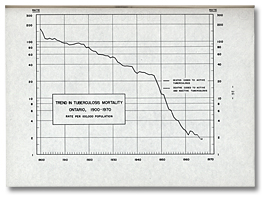
Click to see a larger image (143K)
|
![Photo: Man being tested for tuberculosis at a mobile tuberculosis testing clinic, [ca. 1955]](pics/5201-man-being-tested-270.jpg)
Man being tested for tuberculosis at a mobile |
|||
|
|
||||
|
Effective tuberculosis drugs were finally in use by the postwar years. The communicable diseases such as TB that had been the leading causes of death began to be superseded by chronic diseases, accidents, suicide, and lifestyle diseases as the major killers. The graphs to the left and below illustrate the decline of other communicable diseases throughout the first half of the twentieth century. ![Chart: Diphtheria in Ontario, [ca. 1948]](pics/29863-diptheria-graph-270.jpg)
To see a larger more detailed image (240K),
click here |
|||
|
|
||||
|
More and more, as the costs and complexity of health care rose, governments began to concentrate on helping people prevent disease. Canadians’ demands to do something about the high cost of good medical care also pushed governments to seriously consider the concept of publicly funded medicine: on January 1, 1959, hospital insurance was introduced in Ontario, and on October 1, 1969, a comprehensive system of medicare became available to all. |
||||
|
||||
|
|
||||
|
But medicare didn't really address the issue of preventive health. The promotion of healthy living required a different, far-reaching approach. To reach as many people as possible with the same health_promotion message, the Ontario government began a series of mass-marketing campaigns. These campaigns talked about the health benefits of quitting smoking, following the Canada Food Guide, keeping one’s immunizations up to date, and getting enough physical exercise, among other things. |
![Pamphlet: Do's Dont's for the Wives of Alcoholics, [between 1950 and 1961]](pics/29847-alcohol-dosdonts-270.jpg)
Click to see a larger image (232K)
|
|||
|
|
||||
![Cover: Alcoholism pamphlet, [between 1950 and 1961]](pics/29845-alcoholism-you-270.jpg)
Click to see a larger image (194K)
|
![Inside Cover, Alcoholism pamphlet, [between 1950 and 1961]](pics/29846-alcoholism-you-270.jpg)
Click to see a larger image (213K) )
|
|||
|
|
||||
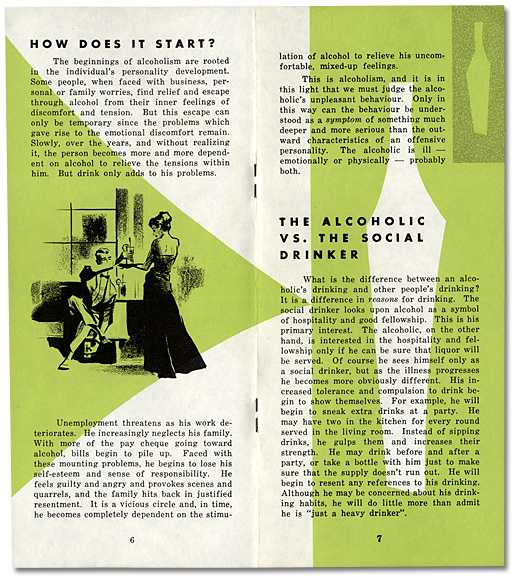
Click to see a larger image (1.3MB)
|
||||
|
|
||||
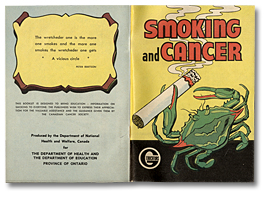
Click to see a larger image (236K) |
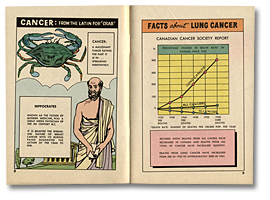
Click to see a larger image (236K) |
|||

Click to see a larger image (228K) |

Click to see a larger image (238K) |
|||
|
Governments were joined in these campaigns by a host of voluntary agencies—the Heart and Stroke Foundation, cancer-research groups, and dietitians. Their combined “social marketing” efforts aimed to get the word out about healthy living to all Ontarians.
Click to see a larger image (268K)
|
![Pamphlet: Your Choice? handout published by the Canadian Cancer Society, [ca. 1963]](pics/40225-your-choice-270.jpg)
|
|||
|
|
||||
|
The 1960s were an especially active time for these mass-marketing campaigns, and the beginning of a whole new understanding of the importance of good health and healthy living. Health educators and other health professionals began to gather at conferences and at symposia to discuss the promotion of healthy living. |
||||
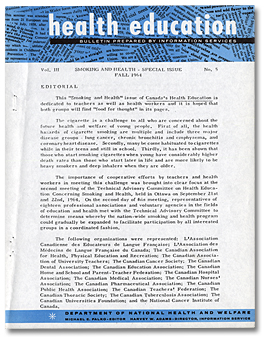
Click to see a larger image (395K)
|
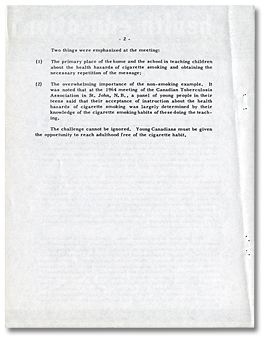
Click to see a larger image (243K)
|
|||
|
They went out into the community and uncovered the sources of poor health and disease - poverty, environmental contaminants, malnutrition, and the like. The health_promotion field developed in tandem with other social movements of the time, such as feminism and environmentalism. These movements challenged old ways of doing things with new ideas and approaches. 
Public Health Inspector testing water quality |
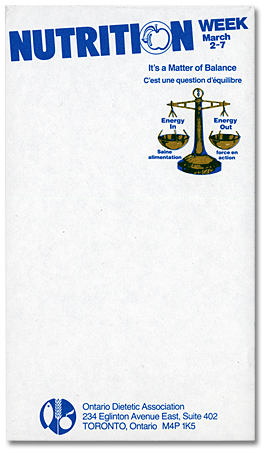
Cover of a brochure about Nutrition Week, 1984 |
|||
|
The Ontario government followed the lead of its health professionals and began to invest in good health for all. It hired more health educators and public health nurses, and began producing a large variety of materials on many aspects of healthy living. Everyone, from the youngest school child to the oldest nursing-home resident, would have access to these materials. |
||||
|
|
||||
![Chart: Scarlet Fever in Ontario, [ca. 1948]](pics/29861-scarlet-fever-270.jpg)
![Chart: Typhoid Fever in Ontario, [ca. 1948]](pics/29862-typhoid-graph-270.jpg)